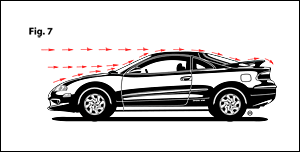
So far all the examples we've talked about are for flat field shots. Wind presents a few extra challenges when throwing around wind blocks and over hills.
Picture a car in a wind tunnel test (fig. 7). Think of how the smoke follows the contour of whatever it is passing over. As the smoke hits the windshield it changes direction and moves upward.
Now, imagine that this car body is a hill and you are standing on top throwing down toward the hood. The wind currents will act as a headwind. Try to follow the contour of the hill if it is a long shot. The up flow will help to lift the disc until it reaches the bottom of the hill (fig. 8).
Turn this shot around and throw towards the trunk of the car. The wind will be blocked by the body of the hill, creating a dead spot on the down slope. Although it may feel like a huge tail wind where you stand, it will actually be almost a normal downhill shot.

What will the wind do to your disc if you are driving from further back on the hill (fig 8a)? Right. It will encounter an almost vertical rise at the crest of the hill. Here are two strategies to help dump elevation:
1. Use a less stable disc wide left and let the anhyzer dump elevation (this works best for longer shots).
2. Use a more stable disc to the right and let the hyzer dump elevation (this works best on shorter shots).
At the end of their respective flights, #1 will finish with a flight or a roll while #2 will be a hyzer spike. Remember that any time the disc is not parallel to the ground, you will be dumping elevation.
Continued... next page (page 1 | 2 | 3)
|